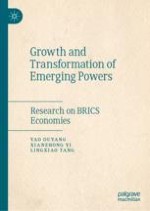2019 | OriginalPaper | Chapter
6. Construction of Brics Financial Cooperation Platform
Authors : Yao Ouyang, Xianzhong Yi, Lingxiao Tang
Published in: Growth and Transformation of Emerging Powers
Publisher: Springer Singapore
Activate our intelligent search to find suitable subject content or patents.
Select sections of text to find matching patents with Artificial Intelligence. powered by
Select sections of text to find additional relevant content using AI-assisted search. powered by
